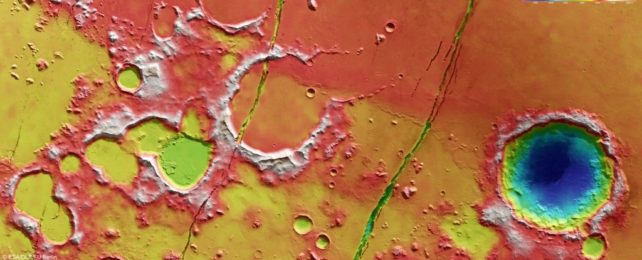Rumbles detected deep inside Mars have promoted speculations over volcanic activity on the red planet from "possible" to "likely".
After studying a cluster of marsquakes detected by NASA's InSight lander, researchers have concluded that molten magma is probably still present beneath the crust of Mars – meaning that the surface of Mars continues to be shaped by volcanism to this day.
It's the latest in a series of clues pointing to volcanic activity persisting on Mars long after it was presumed to have fallen silent.
This could have implications for our understanding of the planet's geology and even the search for life that scientists believe could lurk under the Martian surface.
Up until relatively recently, scientists presumed little was happening deep within the interior of our small red neighbor.
The planet doesn't have a global magnetic field to speak of; since a magnetic field is produced by internal activity, its lack thereof suggested, well, a lack thereof.
But then science happened: NASA sent the InSight lander, equipped with sensitive seismic detectors, and we found out that Mars is rumbling and grumbling with seismic activity – quite startlingly powerful seismic activity, in some cases.
To date, InSight has detected over 1,300 quakes, forever altering our understanding of Martian geodynamics.
Those quakes can reveal a lot about the interior structure and activity of Mars, and a team of geophysicists led by Simon Stähler of ETH Zurich in Switzerland has just conducted a close study of a cluster of 20 recent quakes to gain a better understanding of what's going on in the belly of the Mars-beast.
The team found that the data suggests most of the faults distributed across the entire surface of Mars are not seismically active. Fascinatingly, the cluster seems to originate in a region called Cerberus Fossae. It consists of features called graben – where tectonic activity has caused faults to open up, resulting in blocks of crust slipping down between the parallel ridges of the faults.
The low frequency of the deeper seismic waves, the team found, could indicate a warm source region some 30 to 50 kilometers (18 to 31 miles) below the surface, consistent with molten magma and, therefore, ongoing, present-day volcanic activity. In addition, high-frequency marsquakes seem to take place along the flanks of the Cerberus Fossae graben.
Together, the Cerberus Fossae quakes represent at least half the seismic activity present on the entirety of Mars.
Next, the team compared their data against observational images of the Cerberus Fossae and found deposits of darker dust scattered out in multiple directions from a fissure called the Cerberus Fossae Mantling Unit. This was identified last year as evidence of recent volcanic activity on Mars.
"The darker shade of the dust signifies geological evidence of more recent volcanic activity – perhaps within the past 50,000 years – relatively young, in geological terms," Stähler says.
"It is possible that what we are seeing are the last remnants of this once active volcanic region or that the magma is right now moving eastward to the next location of eruption."
Our growing understanding of Mars shows that the planet has changed a lot over its 4.5 billion-year lifespan.
Layers of sedimentary rock and the presence of aqueous minerals suggest that Mars was once awash with liquid water, implying a world much more amenable to life than the windy red dust-ball that we see today.
Discovering how Mars transformed could help us better understand our world, which is so similar and yet so very different from our planetary neighbor.
And it has implications for the search for life on the broader galaxy: knowing the factors that play into habitability or inhabitability will give important information for assessing potential exoplanet habitability.
There's also the ongoing question of life on Mars. Scientists think that liquid water lakes might be present below the surface. They also very much might not be, but if they are, they would require some sort of heating source to maintain a habitable temperature. The presence of magma would do it.
So the possibility of a gooey center on Mars is definitely an enticing one, and the Cerberus Fossae seems to be the place to go to understand it.
"So far, no other tectonic feature on the InSight hemisphere of Mars has been unequivocally confirmed to be seismically active, and only recently … InSight detected large marsquakes on the far side, in the Southern Tharsis province," the researchers write.
"Since no marsquakes at all have been clearly localized on wrinkle ridges or lobate scarps, that is contractional features, the Cerberus Fossae offers unique insight into Mars's tectonics as a whole."
The research has been published in Nature Astronomy.
